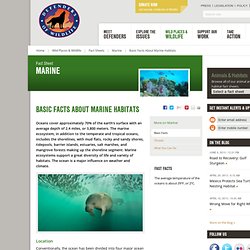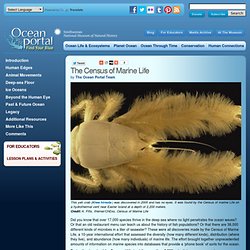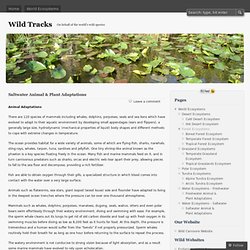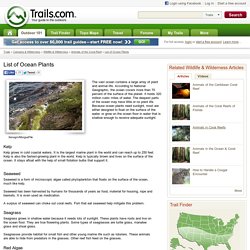

Jellyfish glow. Important Facts about Seagrasses « Citizen Scientist Project. Jellyfish Fact. Ocean Facts. Interesting Ocean Facts Area: about 140 million square miles (362 million sq km), or nearly 71% of the Earth's surface.

Average Depth: 12,200 feet (3,720 m). Deepest point: 36,198 feet (11,033 m) in the Mariana Trench in the western Pacific. Mountains: The ocean ridges form a great mountain range, almost 40,000 miles (64,000 km) long, that weaves its way through all the major oceans. It is the largest single feature on Earth. Basic Facts About Marines. Oceans cover approximately 70% of the earth’s surface with an average depth of 2.4 miles, or 3,800 meters.

The marine ecosystem, in addition to the temperate and tropical oceans, includes the shorelines, with mud flats, rocky and sandy shores, tidepools, barrier islands, estuaries, salt marshes, and mangrove forests making up the shoreline segment. Marine ecosystems support a great diversity of life and variety of habitats. The ocean is a major influence on weather and climate. Location.
Dolphins. Whales. The Census of Marine Life. The Gulf of Maine is bounded by Cape Cod, which juts out from the state of Massachusetts like a hook, and Canada's Nova Scotia coast.

It is a well-researched area because it supports major fisheries, is close to a populated coastline, and has a large diversity of habitats, currents and species. Before the launch of the Census’s Gulf of Maine Area (GoMA) program, scientists thought that 2,000 species lived in the region. By the end of the decade, that number had doubled to more than 4,000 named species in the Gulf of Maine Register of Marine Species. Because fish and fishing play such important roles in this ecosystem, particular species such as cod and lobster have been well studied. But general biodiversity and how those species interact in ecosystems are also important and are still not completely understood. To assess the diversity of fish and where they live, scientists explored years of data collected from trawl surveys by the Northeast Fisheries Science Center.
Sharks. Salt water food chain! Organisms that live in the Salt water ecosystem: - shark, whale, sea eel, dolphin, seal - plankton, seaweed, coral, sea star, sea urchin - shrimp, crabs, jelly fish, sea turtle, clown fish, lobster How the food chain works: saltwater fish relies on photosynthesisenergy produced by the phytoplankton will transfer up the food chain ending in the largest animals of the seaplant cells called phytoplankton make up the total mass of organisms required for species survival.

Seagrass meadows. Introduction Photo 1: Posidonia oceanica meadow in the NW Mediterranean. (Photograph by M. Sanfélix) Seagrasses are angiosperms that are restricted to life in the sea. Algae. Saltwater Animal & Plant Adaptations. Animal Adaptations There are 120 species of mammals including whales, dolphins, porpoises, seals and sea lions which have evolved to adapt to their aquatic environment by developing small appendages (ears and flippers), a generally large size, hydrodynamic (mechanical properties of liquid) body shapes and different methods to cope with extreme changes in temperature.

The ocean provides habitat for a wide variety of animals, some of which are flying-fish, sharks, narwhals, sting-rays, whales, tarpon, tuna, sardines and jellyfish. One tiny shrimp-like animal known as the phaeton is a key species floating freely in the ocean. Many fish and marine mammals feed on it, and in turn carnivorous predators such as sharks, orcas and electric eels tear apart their prey, allowing pieces to fall to the sea floor and decompose, providing a rich fertilizer.
Plankton converts inorganic carbon into sugars that are stored in its cells. Bird Adaptations Ducks have developed webbed feet for swimming. Posidonia Seagrass. List of Ocean Plants. Kelp Kelp grows in cold coastal waters.

It is the largest marine plant in the world and can reach up to 250 feet. Kelp is also the fastest-growing plant in the world. Kelp is typically brown and lives on the surface of the ocean. It stays afloat with the help of small flotation bulbs that support it. Seaweed Seaweed is a form of microscopic algae called phytoplankton that floats on the surface of the ocean, much like kelp. Seaweed has been harvested by humans for thousands of years as food, material for housing, rope and baskets. A surplus of seaweed can choke out coral reefs. Seagrass Seagrass grows in shallow water because it needs lots of sunlight. Seagrasses provide habitat for small fish and other young marine life such as lobsters.
Red Algae Red algae grows in warm tropical water. Coralline Algae Coralline algae consists of very fine filaments that grow over rocks. Coral and Algae Coral is not a plant; it is an animal organism.
Climate Change. Climate of the marine environment. The web www.mccip.org.uk.

Climate scale. Climate region. Global Warming Effects on Salt Water Species. Although marine species are more difficult to see and less well studied than land and freshwater species, they are known to be experiencing some of the same—and some different—effects from global warming.

Forced migrations. Cold-water species are on the move, seeking cooler, deeper, or higher-latitude waters, while warm-water species are moving to places formerly too cold for their survival. Disease. Scientists are detecting marine diseases, such as lobster-shell disease, in waters historically thought to be too cold. There is some indication that higher ocean temperatures—between 86 and 95° Fahrenheit (30 to 35° Celsius)—promote optimal growth of several coral pathogens. In addition, retreating sea ice exerts a cascading influence on marine ecosystems. Also, oceans become more acidic as they absorb carbon dioxide.